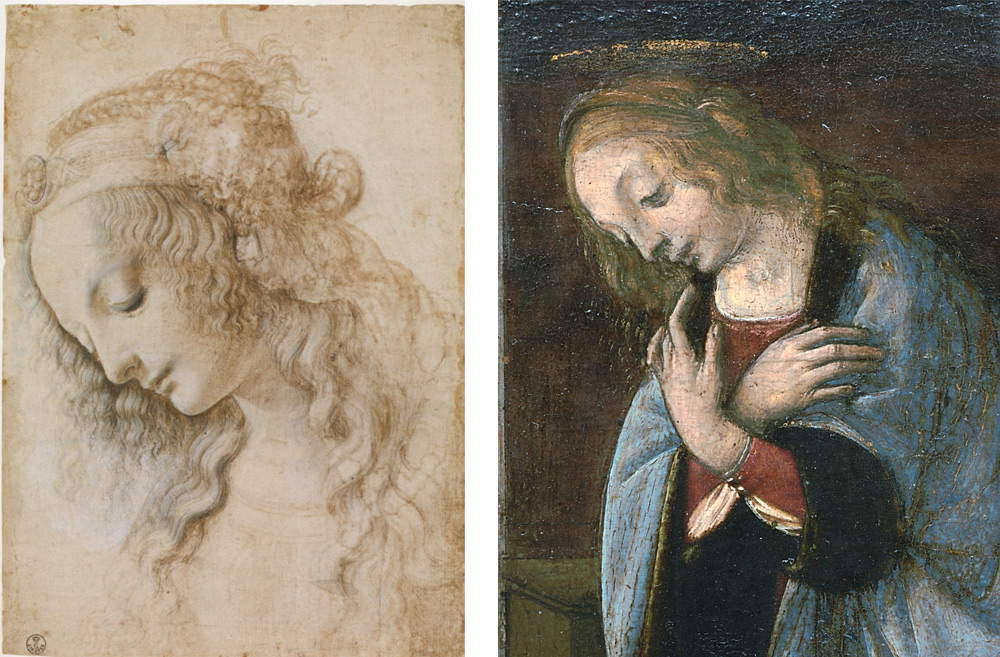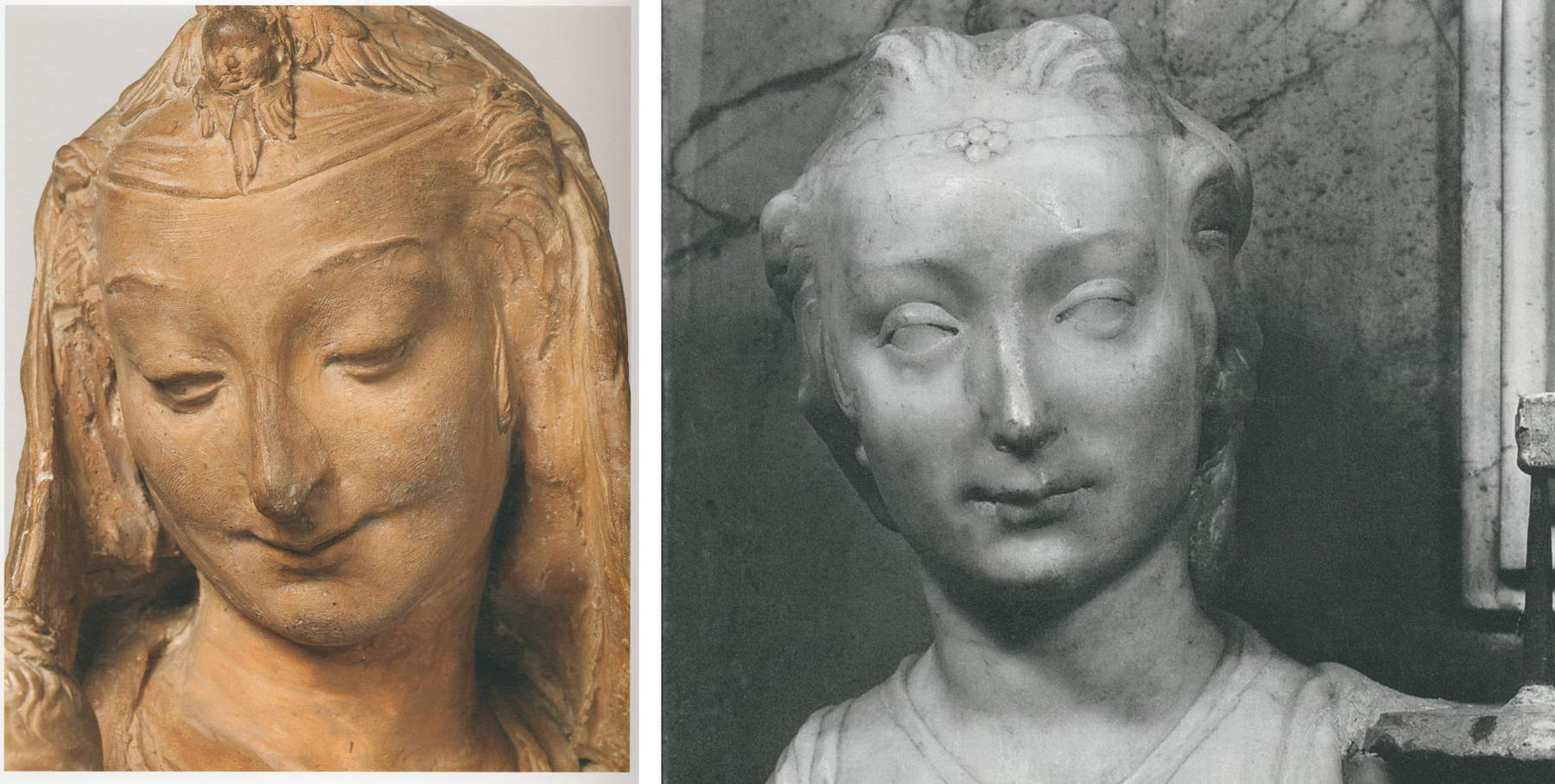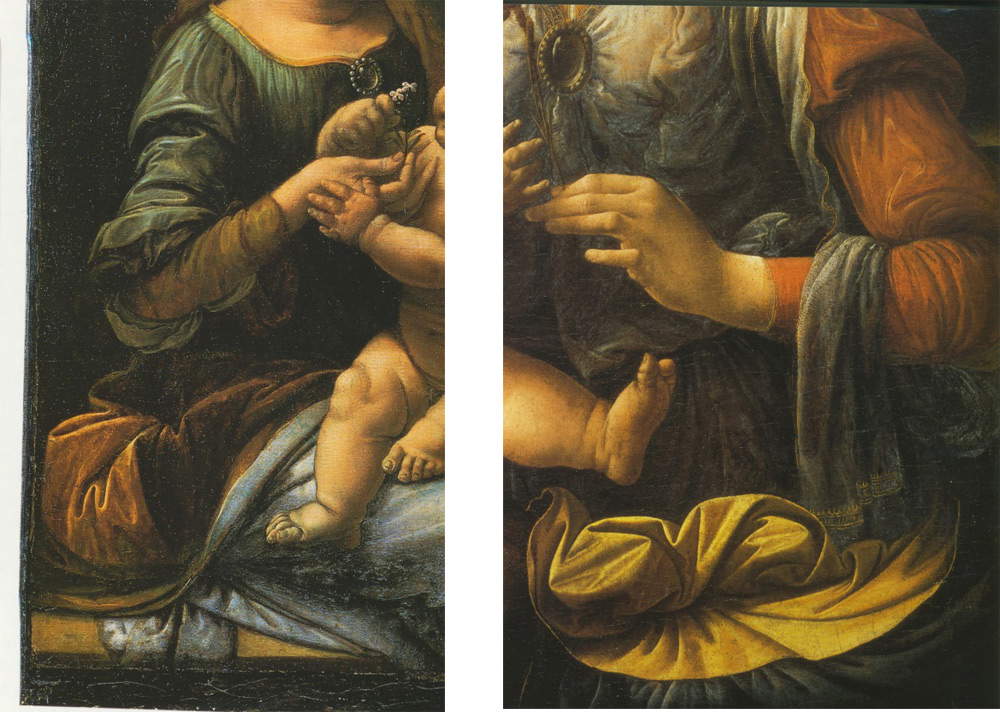The exhibition dedicated in Florence to the theme Verrocchio master of Leonardo (Palazzo Strozzi, March 9-July 14, 2019) is contained in size, well readable, sober in its layout and supported by a concise verbal commentary. It was exciting for me to find myself among old ’friends,’ and finally to see in direct contact many of the pieces that in the past I had had to connect ideally, struggling to overcome difficulties related to time, distance, and viewing conditions. As threadbare as the commentary scheme is, which begins with conventional words of agreement and reserves dissent for the end of the discourse, in this case it is worth noting from the outset the clarity of the setting of the review: the balanced sculpture-painting distribution, the additions offered by the drawings, often limited in number due to the peculiar requirements of the exhibition, the high quality of the whole.
The presentations of some serial groupings, such as Female Busts, Heroic Portraits, then the typology of the Madonna and Child, juxtaposing paintings, drawings, terracotta and marble sculptures, turn out to be very effective in the opening. With some peaks, such as the enhancement of the Profiles of Heroines between Desiderio and Andrea (Caglioti), the revealing comparison between Verrocchio’s Giuliano de Medici and Pollaiolo’s Lorenzo Neroni (to whom is dedicated a card of rare incisiveness, G. Amato), and a few snags: in the judgment of theAlexander the Great (Washington) still weighs the trace of previous devaluations, while in my opinion the marble is representative of that proto-Baroque redundancy that is one of Andrea’s two decisive ’faces’ (but this belongs to my personal idea of Verrocchio’s personality).
Very appropriate is the reference to the Perugian tablets with Stories of St. Bernardino, here effectively apportioned, and even more important are the ’pauses for reflection,’ surrounding the David, the Putto with dolphin, and the Amsterdam Candelabra, protagonists of the theme “the master sculpture of space,” and punctually contextualized by the cards. Nevertheless, some perplexity: the choice to exhibit Desiderio’s Melancholy P utto (Washington) instead of Vienna’s Laughing Putto (although mentioned by Caglioti), which shows the tongue in its teeth, suggests that a comparison with the Child Jesus in the Victoria and Albert Madonna, whose laughter evokes the Dionysian imprint of Donatello’s infants, was avoided... And some missed opportunities: I look at the small and precious complex of terracotta reliefs, which rightly includes the cast for the unfortunately destroyed Berlin Deposition; I refer specifically to the two relief panels with Angels holding up angels in the Louvre, which in my view are manifestly and significantly different. The angel on the right, whose legs are distinctly visible under the cloths, and who turns his head outward showing his somewhat prissy face and elaborate hairstyle, is overtly Verrocchioan, whether Andrea or a collaborator modeled it; the other shows that impatience with tradition that characterized Leonardo from youth to old age: it is all set diagonally, foreshortened, and hovering in the wind, thanks to the perception of that density of the air that so fascinated Vinci (I think of the ’foreboding’ of the helicopter). In my opinion, a Vincentian flying contribution to the tormented realization of the Forteguerri Monument.
That said, it is worth noting that the criterion-guidance of the two curators was (at least on this occasion), marked by a ’re-setting’ work. Rarely resorting to the question mark, the works are qualified mainly from the point of view of attribution, sometimes correcting, elsewhere confirming positions already expressed by the critics, but always looking mainly at the basic theme of the author of the work. And with a peak of innovative cutting in the proposal of Leonardo’s authorship for the now famous terracotta in the Victoria and Albert Museum. Risky premise, for there is no doubt that Verrocchio’s workshop was a multipurpose center, where sharing, collaboration and exchange were widely practiced.
And so, despite the fact that the introductory essays by the two editors and the individual entries contain multiple historical and historiographical clarifications, the theme of ’authorship’ is dominant, and an initial reflection should be devoted to this. Those who look at the dense series of studies devoted to medieval art (pre-13th century) know that the work of art, drawn/painted/sculpted/miniated, is a structure that offers ample possibilities for study even in the absence of the name of the person who elaborated it. A fortiori, this is true of much of the study devoted to the history of literature and the history of music where the authorship of works is rarely in question, and where research is based primarily on text analysis. Therefore, a methodical approach in which stylistic reading-perhaps literarily valuable, and nonetheless fluid-is primarily channeled toward the search for a name, often leaning on the visual and tactile sensibility of the critic, is questionable. Placement in a precise historical context, relationship with the public, adherence to or contrast with cultural circulation cannot be placed second to the identification of an artist, since the strength and density of the image are expressed even beyond the identity of the author.
Taken for granted, and generally disregarded, assertions, but I will try to qualify them through other segments of the exhibition.
The question of the Verrocchio painter. The fact that two sides offering different interpretations of the figure of the master can be distinguished in the dense critical affair should already invite caution. On the one hand, Andrea is recognized as a multifaceted personality, possessing a wide range of skills and a dexterity suited to different forms of elaboration, implicitly ascribing to the same person a truly impressive body of work (and this seems to be the position of the exhibition curators). On the other hand, the slowness in working attested documentedly, the defaults, the unfinished works lend support to a different reconstruction of the personality that turns out to be cultured, lively, but also variable in orientation; authoritative promoter of solutions of aniconic and even abstract cut (the two Medici tombs in San Lorenzo), but also author of a strongly figural and tumultuously modeled structure such as theIncredulity of St. Thomas. An alternative that sees Verrocchio predominantly engaged in working with marble, earth, and metal, but also a busy and shrewd entrepreneur, capable of grabbing the work of temporary collaborators to fulfill painting commissions. There is a lack of clarity on this point in the exhibition: following attribution criteria linked to personal opinions, space is given to the presence in the workshop of Perugino and Ghirlandaio, but the contribution of Piermatteo d’Amelia is sacrificed, and especially that of Botticelli, who is also in various forms credited, and who has a substantial advantage over the others: in Leonardo’s youthful notes, Sandro (and only he) is mentioned twice as an interlocutor on problems of style; well would he be credited with not only one of the two angels in the Baptism, but also the Madonna and Child on her lap (Berlin) , imbued with Lippesque stylistic features. And again: the presence of Lorenzo di Credi in the workshop is reported, but in a contradictory form; his role is explicitly reduced in relation to the Pala del Duomo di Pistoia, whose rigorous perspective intavolatura is ignored (impossible to refer it to Leonardo, but hardly congruent even with Andrea); he is denied the canvas depicting the Holy Bishop (convincing evidence of Credi’s pathetic and even tearful declension), but the Dreyfuss Madonna and theAnnunciation in the Louvre are referred to him in toto . The juxtaposition of the diminutive Dreyfuss and Credi’s Turin Madonna explicitly shows that Lorenzo’s glazed and compact forms are a far cry from the sophisticated chromatics of the Washington and Louvre tablets. Ironically, a similar Leonardo/Credi juxtaposition had already been proposed in the 2015 Milan exhibition, but with the opposite intent, that is, precisely to demonstrate Dreyfuss’s vincian autography. After all, the layout of the Catalogue and some of the proposed comparisons are revealing (pp. 54, 59, 247, etc.).
 |
| Left: Leonardo, Study of a Female Head (Florence, Uffizi, Gabinetto Disegni e Stampe. Right: Leonardo and Lorenzo di Credi?, Annunciation, part (Paris, Louvre). |
 |
| Left: Leonardo and Lorenzo di Credi?, Annunciation, part (Paris, Louvre). Right: Leonardo, Study of drapery on kneeling figure (Rome, Gabinetto Nazionale delle Stampe, Fondo Corsini) |
 |
| Left: Leonardo?, Madonna and Child, part (London, Victoria and Albert Museum). Right: Desiderio da Settignano, Altar of the Sacrament, part (Florence, San Lorenzo) |
 |
| Leonardo, Details of Madonnas preserved in St. Petersburg (Hermitage) and Munich (Alte Pinakothek) |
Quite other reasons could be given, but I recall at least one of the many possibilities for comparing the various Madonnas: in the series assigned in the exhibition to the Verrocchio/Perugino duo, the hands of the figures reveal the casual use of earthen or plaster models employed for right and reverse in the various panels; a mode of work widely used and practiced, which seems not to be detected in the Catalogue, and which Leonardo would never accept, in the early trials as in the rest of his work; beyond the very small size, the hand of the Dreyfuss Madonna offering her son a pomegranate shows an absolutely unprecedented foreshortening: I do not know if it can be considered evidence at all , but it is at least strong support for the Vincian authorship.
The terracotta Madonna in the Victoria and Albert Museum. I have already expressed my doubts about an attribution to Leonardo that Caglioti traces (with some candor) back to his high school years, that is, to an age before his apprenticeship as an art historian: the conviction seems to be grounded in the hands with tapering fingers and the mother’s smile, a form that sees the corners of the mouth rise up over which the nasal septum descends steeply, almost an extension of the seraph wing dropping from the forehead (see the beautiful figure on p.283): a formulation for which one should at least evoke the ’surfacing smile’ proper to Desiderio’s angelic creatures, and in relation to which Caglioti stumbles quite uncharacteristically by placing on the same plane the seraphim, an emblematic allusion to Mary’s prophetic capacity, and the jewel that stops on the forehead the hairstyle of a famous female Head by Leonardo (Uffizi); but perhaps I have misunderstood, and it is my habit to apologize. In the same terracotta, the well-excavated drapery that rests on the Virgin’s knees shows no affinity with the intricate draperies of the Verrocchio sculptures, but it is not matched either in the drawings on linen cloth on display in the exhibition, and which I have discussed on several occasions; as also noted in the Catalogue, those on display have marked affinities with the great Vincian Annunciation in the Uffizi (the curved posture of the Angel, the support point of the cloth to the right of the Annunciata). In relation to the distribution of the components of the group to more than one author, which not even the curators of the exhibition shy away from, I note that only the young Leonardo reserves the right to crowd the cloth into clusters of folds independent of the fall of the cloth(Madonna of the Carnation), and this should suffice to identify Leonardo himself as surely the promoter of those refined experiments, which remained confined to a group of fragile fragments of cloth...
With reference to the inelegant comment published by Caglioti in the interview in Repubblica, and to the probable ’deafness’ of older critics, I prefer to add a clarification. I do not complain about the limited citations of my work (present where they are not significant, absent where it would have been necessary): those who speak frankly, and without the protection of a friendly line-up, know that they are exposed; not so much to criticism as to thunderous silence.
Finally, I confess that I took leave of the exhibition with the face of the victorious David firmly fixed in my eyes and mind: a face both youthful and mature, self-conscious and at the same time ironic, almost a coda to the debate of modern interpreters: allow me to indulge once in a while in the deprecating instinct, and to recognize in it (others have already said so), the beautiful features of the 15-year-old Leonardo.
Warning: the translation into English of the original Italian article was created using automatic tools. We undertake to review all articles, but we do not guarantee the total absence of inaccuracies in the translation due to the program. You can find the original by clicking on the ITA button. If you find any mistake,please contact us.